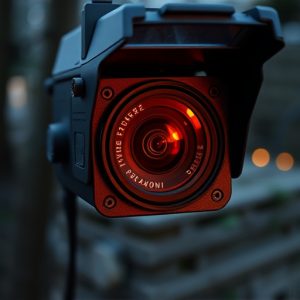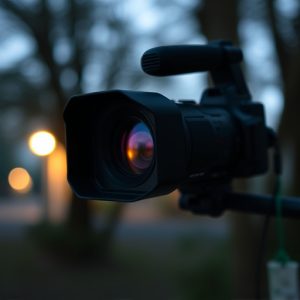Battery-Powered Spy Cameras: Guide to Ethical Outdoor Placement
Battery-powered spy cameras have transformed outdoor surveillance with their discreet, portable desi…….
Battery-powered spy cameras have transformed outdoor surveillance with their discreet, portable design and extended battery life. Ideal for hard-to-reach areas without constant power, these cameras offer features like motion sensors, night vision, and weatherproof designs. For optimal placement, strategically position them in hidden spots like branches or rocks, ensuring clear visuals and minimal interference. Ethical deployment requires understanding local regulations regarding privacy, consent, and data protection to mitigate legal risks while leveraging the benefits of this powerful technology.
“Uncover the power of covert monitoring with our comprehensive guide, tailored for professionals. Explore the world of battery-powered spy cameras and their transformative role in outdoor applications. From strategic location selection to ethical considerations, this article equips you with insights for successful implementation. Learn how to set up a robust system that ensures effectiveness while navigating legal guidelines. Discover the art of discreet surveillance, enhancing security and peace of mind.”
- Understanding Battery-Powered Spy Cameras: Outdoor Applications
- Choosing the Right Location for Covert Monitoring
- Ethical Considerations and Legal Guidelines
- Setting Up a Reliable and Effective covert Monitoring System
Understanding Battery-Powered Spy Cameras: Outdoor Applications
Battery-powered spy cameras have transformed outdoor surveillance, offering a discrete and portable solution for professionals in various fields. These compact devices are designed to capture high-quality footage while drawing minimal power from their internal batteries, ensuring they can operate for extended periods before needing recharging. This feature makes them ideal for outdoor applications where constant power sources might be unavailable or impractical.
From security guards monitoring remote areas to wildlife researchers tracking animal behavior, professionals across sectors benefit from the versatility of battery-powered spy cameras. Their lightweight construction allows for easy placement in hard-to-reach locations, enabling users to gather valuable data and evidence without detection. Moreover, these cameras often come equipped with advanced features like motion sensors, night vision capabilities, and weatherproof designs, enhancing their performance in diverse outdoor environments.
Choosing the Right Location for Covert Monitoring
When setting up a covert monitoring system, selecting the optimal location for your battery-powered spy camera outdoor is paramount. Consider environments that require discreet observation, such as remote areas or private properties, where the camera can remain hidden without drawing attention. Strategically placing the device in plain sight but out of direct view can significantly enhance its effectiveness.
For instance, mounting the camera on a tree branch, inside a fake rock, or behind a sign post can provide ideal cover while still allowing for clear visuals. Ensure the chosen spot offers adequate line-of-sight to capture the desired area without obstructions from trees, buildings, or other elements that might obscure its view. Proper placement will ensure continuous, high-quality surveillance with minimal interference.
Ethical Considerations and Legal Guidelines
In the realm of covert monitoring, especially with the use of battery-powered spy cameras designed for outdoor installation, ethical considerations and legal guidelines play a pivotal role in ensuring responsible deployment. These small yet powerful devices, capable of capturing high-resolution footage discreetly, must be utilized with utmost care to respect privacy rights and comply with relevant laws. It’s crucial for professionals installing such systems to understand the legal boundaries, particularly regarding consent, public versus private spaces, and data protection regulations.
Navigating these ethical and legal aspects requires a nuanced understanding of both local and international laws. For instance, many jurisdictions have strict rules on surveillance, especially in areas like residential neighborhoods or public parks. Professionals must be adept at obtaining proper authorizations, ensuring transparency with clients, and safeguarding the privacy of individuals caught within the camera’s field of view. Adhering to these guidelines not only mitigates legal risks but also enhances the credibility of the monitoring system industry as a whole.
Setting Up a Reliable and Effective covert Monitoring System
Setting up a reliable and effective covert monitoring system requires careful consideration and strategic placement. When using battery-powered spy cameras outdoors, ensure they are hidden in plain sight to avoid detection. Look for locations that offer unobstructed views of the area you want to monitor, such as corners, behind objects, or under structures. These hidden cameras should be equipped with night vision capabilities to capture clear images and videos even in low-light conditions.
Properly securing and camouflaging your battery-powered spy camera outdoor is crucial for long-term effectiveness. Use sturdy mounting hardware to prevent disruptions from weather or tampering. Camouflage the device with natural elements like plants, rocks, or wooden structures to blend seamlessly into the environment. Regular maintenance, including checking battery life and cleaning lenses, will ensure continuous and reliable monitoring.
In conclusion, the strategic placement of a battery-powered spy camera in outdoor environments offers a powerful tool for surveillance. By understanding the technology, ethical boundaries, and legal frameworks surrounding covert monitoring systems, professionals can ensure effective and responsible implementation. With the right knowledge, these devices become valuable assets for various applications, enhancing security while navigating the intricate balance between privacy and observation.


